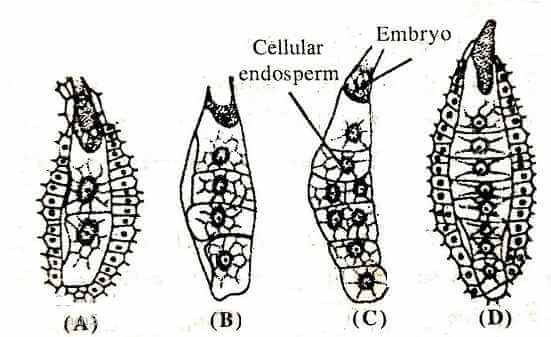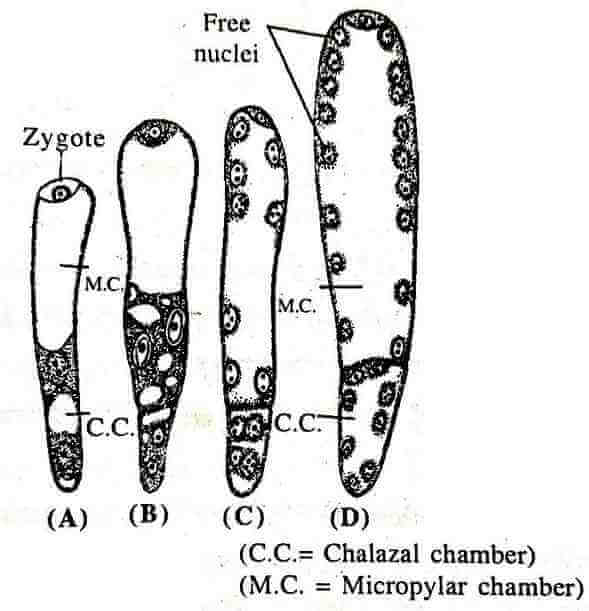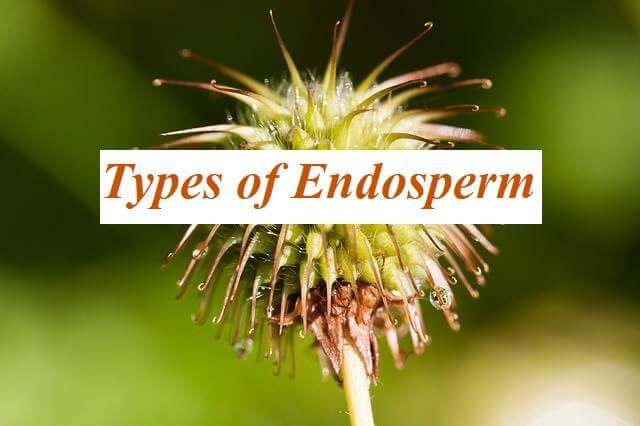What is Endosperm?, Types of Endosperm? , Examples of Endosperms?
We have already read that endosperm formed as a result of vegetative fertilization in the previous post. Here we are going to discuss basic information about endosperm, types of endosperm, some important terms related to endosperm.
What is Endosperm?
Endosperm develops from triploid primary endosperm nucleus formed after vegetative fertilization in the case of angiosperm but in the case of gymnosperm endosperm is formed before fertilization. The endosperm of a gymnosperm is always haploid whereas endosperm of angiosperm is always triploid.
The endosperm is the nutritive tissue which gives the nutrition for developing embryo as well as a seedling.
Read Also- Fertilization in plants: Definition, Process
Types of Endosperm
There are mainly three types of endosperm occurs in nature
1. Nuclear Endosperm

As name suggests that this type of endosperm is related to Nucleus. Nuclear endosperm formed with the help of mitotic free nuclear divisions without the formation of the wall. a large number of free nuclei formed in the central cell of the embryo sac. A big Central vacuole develops into the embryo sac. This vacuole pushing all the nuclei to the peripheral cytoplasm. Then the cell wall formed.
Example- coconut
2. Cellular Endosperm

The first nuclear division of the primary endosperm nucleus is done immediately followed by the wall formation. This division forms two equal-sized chambers. These two equal sides Chambers are called the chalazal and micropylar chamber. The subsequent divisions are followed by regular cell wall formation.
Example- Datura
3. Helobial Endosperm

Helobial endosperm development is an intermediate type of endosperm between cellular and nuclear types. Endosperm nucleus division is followed by wall formation and two chambers are formed (chalazal and micropylar chamber). In general chalazal cells does not divide further and function as haustorium. But the nucleus of the large micropylar cell formed nuclear endosperm by repeated free nuclear divisions.
Example- Erumurus
Read Also – 12 Major Difference between Self-Pollination and Cross-Pollination
Mosaic endosperm- is the use of endosperm is not homogeneous but there are patches of different colours this situation is called mosaic endosperm. This is a very rare case. The mosaic endosperm is discovered by Webber in 1990 in Zea mays plant.
Ruminate endosperm- ruminate endosperm is called when mature endosperm with irregularity and unevenness in its surface. Ruminate endosperm is found in about 30 to families of Angiospermic plants
Examples- Annonaceae, Palmae
Xenia- effect of pollen on endosperm is known as Xenia. The term “Xenia” is given by Focke in 1881 during the study of reproduction in Maize.
Metaxenia- effect of pollen on semantic tissues lying outside the endosperm is called Metaxenia. The term “Metaxenia” is given by Swingle in 1928 during the study of reproduction in Datepalm.
Other terms
Here we have discussed “Endosperm: Types of Endosperm | Examples” we hope you like this article. if you have any query or suggestion, please leave a comment on the email. or contact us from contact us page.
Follow our official groups on Telegram, Whatsapp and Facebook

